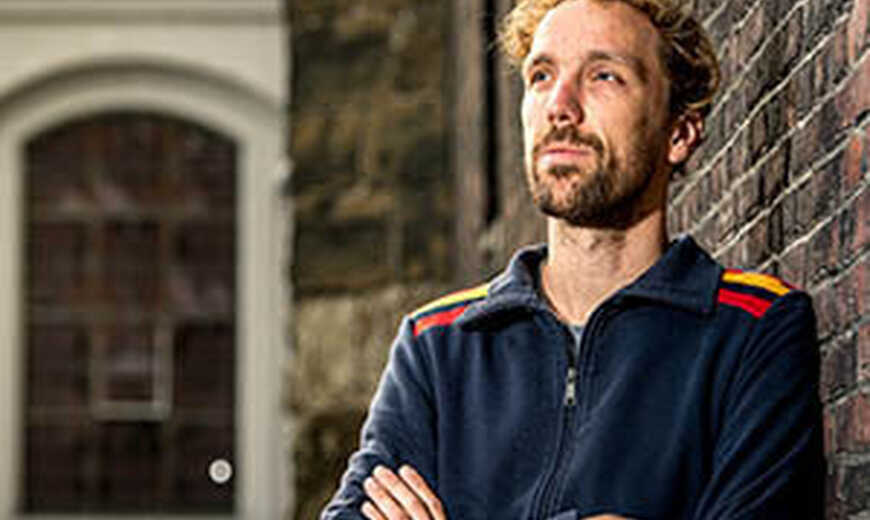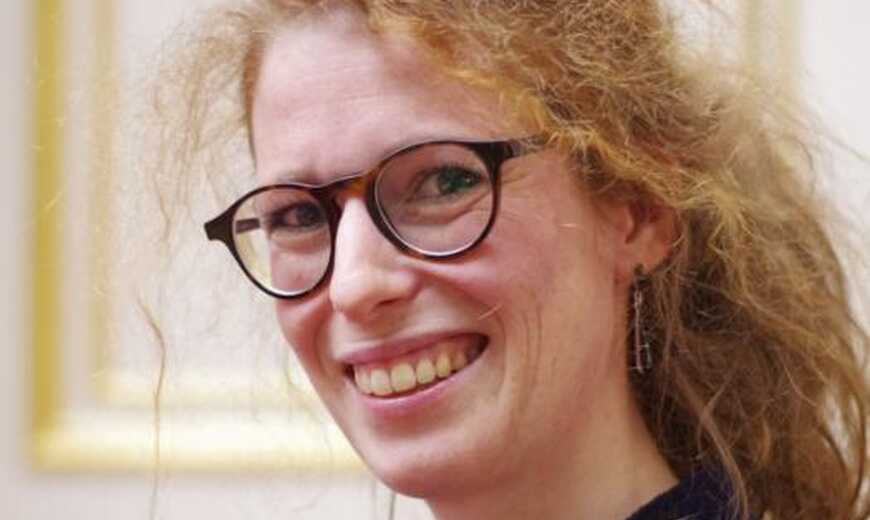Olivier Collignon, you are an FNRS “chercheur qualifié” working in UCLouvain, but with affiliations to labs in Italy, Switzerland … What’s your background? What brought you (back) to Belgium?
[OC] I have a background in clinical psychology, from ULiège, and I picked neuropsychology and cognitive behavioural therapy as options. For a while, I really hesitated between the idea of being a clinician or a researcher. Shortly after defending my master thesis, one of my Professor (Serge Bredard) told me that an engineering lab directed by Prof. Claude Veraart and affiliated to UCLouvain was looking for a PhD student with a psychology background. They were developing invasive and non-invasive prostheses for the blind and thought a psychologist with expertise in cognitive processing would be an asset to interface the engineering aspects with what was relevant for the blind community. I got involved in developing a non-invasive algorithm aimed at transforming images into sounds. It was not easy, but it was very formative, on many levels, like to learn how to weld cables ;-). From early on, I got imprinted by this engineering world.
Despite the fact the project was interesting, it was not providing results that could be used for a PhD thesis. Actually, in the middle of my PhD, with almost no data and plenty of engineering problems, I went to my supervisor, and said that I wanted to quit. Instead of quitting, my advisor suggested that I’d go for 3 months to Canada, in a team that was really interested in the prosthesis I was developing. In fact, they were interested in using Transcranial Magnetic Stimulation (TMS) to interfere with the occipital cortex of blind people who are using this prosthesis, to see if it disrupts the way they use the prosthesis. So I went to Montreal, and this put me back on track: I was looking at the role of the occipital cortex (normally, visual cortex) in blind individuals. I dropped the prosthesis aspect of my PhD project, and focused more and more on how the occipital cortex of blind people reorganize to process sounds. It was more fundamental research, and therefore more grounded in existing literature. Somehow serendipitously, we discovered that when disrupting the right dorsal stream of blind individuals with TMS, we observed that this selectively interfered with sound localization but not with the processing of sound pitch or intensity. Since this region typically processes visuo-spatial information in sighted people, these results suggested that the plasticity we observe in blind people follows organizational principles rooted in the region that gets invaded by crossmodal inputs. This really launched my research career: I am still working on that kind of stuffs now! When I came back from Montreal, I continued to use TMS to probe the function of the occipital cortex of sighted and blind people collaborating with Prof. Etienne Olivier. Then I defended my thesis in 2006 at UCLouvain and went back to Montréal as a postdoc- I really fell in love with this city and the people there at that time. During this postdoc, I continued my research on brain plasticity in blind individuals and extended my interest for multisensory integration. Importantly, I enlarged my technical toolkit with functional Magnetic Resonance Imaging (fMRI), Magnetoencephalography (MEG) and Electroencephalography (EEG), including intracranial recordings in epileptic patients.
In 2011 I was offered a 5-year PI position in Trento, to join CIMEC, the center for mind and brain science. Again, this was a very interesting period. I extended my research program to deaf people, for example observing that that the voice-selective areas of the temporal cortex reorganized specifically to process faces in deaf people. We think that this is because face and voice share functional similarities. It also showed that the rules that govern crossmodal plasticity in blindness can also be found in deafness. During this period, I sharpened my analytical skills including all sort of multivariate analyses and techniques from machine learning.
Soon after arriving in Italy I got an ERC. That was a game-changer: suddenly, I was working with 6 PhD students and 2 postdocs. I got tenured in Trento, but I was always very interested in the FNRS position, for several reasons: research opportunities but also family. Eventually, I came back to Belgium in 2016, after about 11 years abroad.
[interviewer] What are your main research topics, and your dream projects for the future ?
My main research interest is at the frontier between multisensory integration, and the plasticity associated to sensory deprivation.
With respect to multisensory integration, our different senses capture different energies in the world. The brain is constantly bombarded with information, and needs to segregate what does not belong together, and to bind coherent features together. The question is: how does it do that? Of course we have classical hierarchical models of this, claiming that information is processed in the sensory systems, and then integrated in associative regions. What’s clear now is that the data does not fit these models: multisensory integration happens very quickly, seamlessly, at the earliest stages of information processing. In fact, multisensory information is exchanged at almost every level of the central nervous system. I am trying to understand how these multisensory interactions happen. My mantra is that the sensory sub-regions that works together, connect together (Borrowed from the classical Hebbian adage). For instance, we showed that a specific connection exists between planum temporale and V5, two areas that process motion in different modalities.
My other goal is to understand how this multisensory architecture reorganizes when individuals lose access to one sense. Our hypothesis is that the system reorganizes by relying on this pre-existing multisensory architecture: the leftover part of the brain gets recruited by another modality, but not in a random fashion ! It does so by following functional routes. So V5 will get recruited by moving sounds or touch in blind individuals.
In the future, I’d like to go back where I started: applied research. I’d like to see how I can use the methods and results we developed in the last years to potentially predict, help or design rehabilitation strategies that are tailored for sensory deprivation. I’d like to understand how the re-acquisition of sight or hearing would interact, and potentially interfere with neural plasticity associated with sensory deprivation. We have started some important project in this direction for instance working with blind people born with dense bilateral cataract and recovering sight or deaf people recovering hearing with cochlear implant.
In fact, I do have a dream project: to go in developing countries, and work with kids who grow with sensory deprivation for years before being provided with sensory input. Nowadays, in Belgium, a kid that is born deaf or blind would be provided with some sensory restoration in the within the first year of life. However, a brain that has been deprived from sensory stimulation for 10 years has massively reorganized, so I’m really curious about how they develop after sensory restoration. My dream would be ton be able to follows kids that recover sight or hearing for years.
[interview] Where is your field heading to in the future ? Are there initiatives that you are particularly excited about/have contributed to, that might shape the development of cognitive neuroscience ?
Being involved in cognitive neuroscience, doing research involving a lot of neuroimaging, my field evolves very quickly, due to technical aspects. More and more, we need to deal with an engineering aspect associated with the data acquisition and data analysis. This creates a need for multidisciplinary teams. This is the real challenge in my field: being at the frontier between cognitive science, neuroscience and engineering. There is a lot to learn/teach within the timeline of a PhD. Doing even one good research project in four years is a challenge. I believe a challenge for the future of this field in Belgium will be to create centers for cognitive neurosciences that have researchers with multidisciplinary backgrounds, including engineers and physicists.
[interviewer] You run a very multidisciplinary, and international lab. Is there an advice you’d like to share about running such a big lab ?
My first advice would be: don’t do that, because it’s a nightmare : )
But if you really need/want to do this, my second advice would be to keep calm. There are many challenges in running an international, multidisciplinary lab across countries. If you can’t keep calm when facing challenges – it’s probably not a good idea to do it.
Running a lab is somehow bigger than you: it requires you to create partnerships with people who you can trust, this is really key. Despite all the challenges, I try my best to keep it cool. And of course, try to find the right balance between research and your personal life.
To conclude, if you are interested by our work or by this field of research, come at the next International Multisensory research forum - https://imrf2023.sciencesconf.org - that my lab is organizing at the end of June 2023 in Brussels.
Meet the lab series: Interview with Prof O. Collignon
Written by Tim VantilborghSimilar articles
All articles
Meet the lab: Interview with Dr Stijn Van Petegem (ULB)
This interview is part of the meet the lab series and was published in our October 2021 newsletter.
Read more
Meet the lab: Interview with Tool2Care
This interview was part of our March 2022 newsletter.
Read more
Meet the lab: Interview with Jozefien De Leersnyder (KULeuven)
This interview was published in our July 2022 newsletter.
Read more